Yielding primacy in the gardens of apples, cherries, plums and pears, cherry is not far behind in the selection of new varieties. A special place is occupied by the columnar trees.
They allow you to get a good harvest in the cramped conditions of a small garden. On an industrial scale colony cherries show high results in intensive economic conditions.
Table of contents
Characteristics and features of the columnar cherry
A columnar cherry is a tree in the shape of a cylinder that grows only upwards. The crown is formed by short lateral branches and does not exceed one meter in diameter. The peculiarity of the lateral branches in a large number of fruit shoots and the absence of strong branching.
Advantages and disadvantages of a columnar cherry
Colony cherry gives a lot of advantages in growing on the site, namely:
- Decorative. Trees will preserve the integrity of any landscape direction in the design area. Being a novelty in breeding, varieties do not leave indifferent among enthusiastic gardeners.
- Compactness. Cherry, due to the small diameter of the crown allow you to use less space under the fruit trees. They are easy to process, crop and harvest.
- Skoroplodnost and taste. Varieties were bred with preservation of the basic taste characteristics of classic cherries. Technical ripeness in different varieties comes from the beginning to the end of June and allows you to enjoy vitamins in early summer.
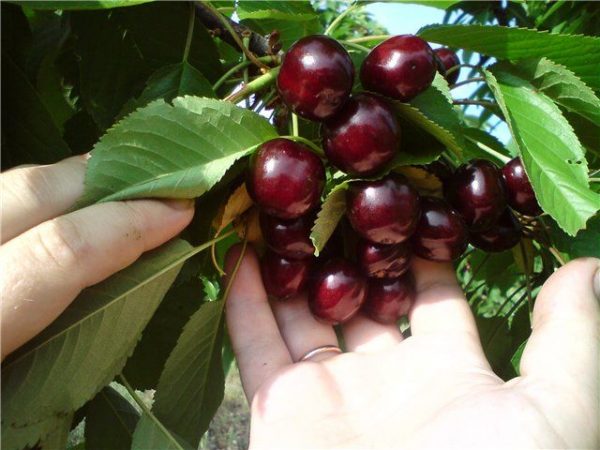
Planting colloid cherry
Seedlings are available for sale in garden centers, in nurseries, through online stores. The choice is better to stop on the seller with a good reputation, which guarantees the compliance of the tree varietal characteristics. Personal inspection will avoid frustration. A good seedling has the following characteristics:
- The bud of the apical shoot is alive, without signs of damage.
- The barrel is flat, without curvature. The bark is smooth.
- On the roots there is no rot and dead tissue. The roots are alive.
- Leaves (if any) without damage and pests.
When purchasing several cherries, choose plants of the same age for the garden.
The landing itself depends on the region. In the northern regions of the autumn planting is not recommended: seedlings do not have time to take root and freeze. In the southern regions and central Russia can be planted in the fall and spring. Autumn planting is productive in the south: the tree takes root, passes the period of adaptation and is no longer sick in the spring.
When choosing a place, note that the columnar cherry:
- afraid of the wind;
- loves light, loose and nutritious soil;
- prefers southern slopes with deep groundwater.
Landing:
- Two or three weeks before the purchase of seedlings, prepare a planting pit in a permanent place. The diameter is 80 cm. The depth is 70 cm. For several trees, the spacing between rows is 3 m. The distance between seedlings of the columnar cherry is 1 m.
- Prepare and put a nutritious mix in a landing hole in a landing hole. This will require humus and black soil, respectively, 1 and 3 buckets, mixed with potash (16 g.) And phosphate (12 g.) Fertilizers.
- The roots of the seedling moisturize and straighten on the hill of the nutrient mixture. Put a backup near. From above, not reaching 2 cm from the root collar, covered with earth. Lightly tamped.
Care and pruning
The complex of care measures includes watering, fertilizing and pruning.
Kolonovidnaya sweet cherry fruits abundantly, so in the dry summer and the first two years after planting, it needs regular watering. In the first year, it is necessary to remove all the ovaries to increase survival.
In spring, trees are fertilized with nitrogen-containing feedings, whenever possible of organic origin. In the fall, potash-phosphorus complexes are laid. Consumption should not exceed the recommendations of a particular manufacturer.
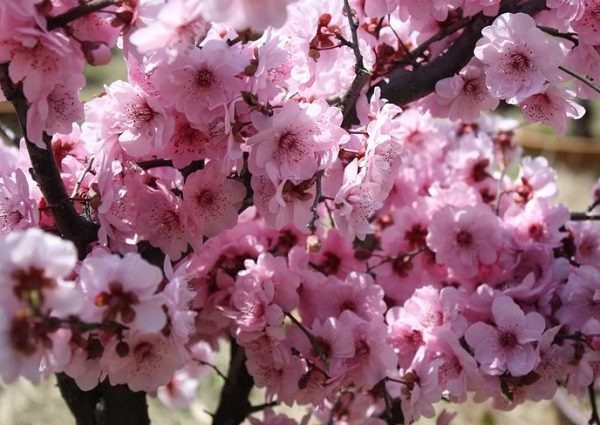
Agrotechnics implies the absence of weeds and full harvesting of plant residues in the fall.
Pruning of colloidal cherries has its own nuances:
- Classic schemes. Instead of increasing the number of shoots, it leads to their intensive growth. Summer bending is unproductive, as it reduces the winter hardiness of plants. Pinching side shoots is also pointless. This does not ensure their transformation into fruitful branches.
- Hedge. Productive only in the first few years of cultivation. Then there is a deterioration in taste and a decrease in yield due to the thickening of the crown.
- Cup shape. Permanent pruning of the upper branches and the formation of the crown side shoots. Genetic tall cherries make such manipulations senseless and time-consuming.
To simplify the task of forming a columnar cherry can scheme:
1st year. Pinching side shoots at a distance of 10 cm from the main trunk.Top removal.
2nd year. Pinch the top when it grows centimeters at 30. Side shoots - at a level of 20 cm from the trunk.
3rd year. Top shoot pinch. Side branches cut at a distance of 30 cm from the main trunk.
4th year. Cut thin, shading the trunk twigs.
5th year and the next. Stop the growth of the tree up: constantly cutting off the top at the level of 2.5-3 meters depending on the variety.
The 6th and every three years after it cut the side shoots on the diameter of the moldable crown.
How does a sweet cherry breed?
At home, colony varieties of cherries multiply with:
- Inoculation As a stock, choose biennial cherry seedlings. Graft necessarily leave to grow with a few sprigs of the rootstock.
- Underwire. The probability to save varietal characteristics is only 50%. Bones are sown in pots in loose, nutritious mixture with sand (1: 1). Sprouts are left in a warm place until May. Then planted in open ground. Cherry can be transplanted to a permanent place in a year, when the plant is stronger.
- Cuttings. Cut branches are treated with root formation stimulants and rooted in loose soil.
Popular varieties of columnar cherries
Superiority among the columnar cherry belongs to the varieties Helena and Sylvia. Sam, Little Sylvia, Queen Mary and Black are a bit behind. As one of the last generations in breeding, columnar cherries have a moderate winter hardiness and high skoroplodnost. Yield per tree is 12-15 kg.
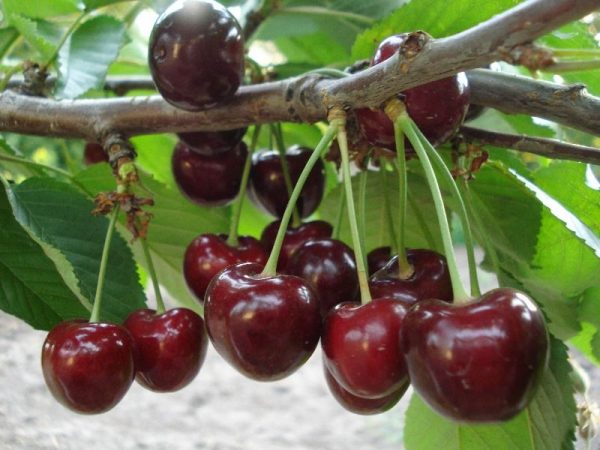
Helena
The ruby-red fruits of the columnar cherry Helena weigh on average 12-14 g. The variety is characterized as dessert. The juicy, half-chewed flesh is colored dark red with pink veins.
Sylvia
According to taste, weight and appearance, Sylvia's columous cherry fruits do not differ from the Helena variety. Dimensional signs are similar. However, the ripening dates come June 12-18. The tree retains a yield of 12-15 years.
Sam
The earliest of the varieties - Sam. Fruits, externally and in taste similar to Sylvia and Helena cherries, ripen on June 10-12, but have smaller sizes: 10-12 g. Trees do not differ in size. Fruits about 15 years. With the observance of agricultural technology - more.
You may also be interested in the following articles about sweet cherries:
Little Sylvia
Reduced version of the Sylvia variety: the height of the trees does not exceed 2 m. The crown does not grow beyond half a meter in diameter. Maturing term - the end of June. Fruits in all respects correspond to the variety Helena.
Other varieties
Gardeners are gaining popularity with the variety Queen Mary and Black Column Cherry. Trees do not exceed 2-2.5 m in height and 50 cm in width.
The colony cherry in the breeding process has acquired good self-pollination indicators. Harvest can be increased by planting several trees next to each other. Universal pollinator is Sam.
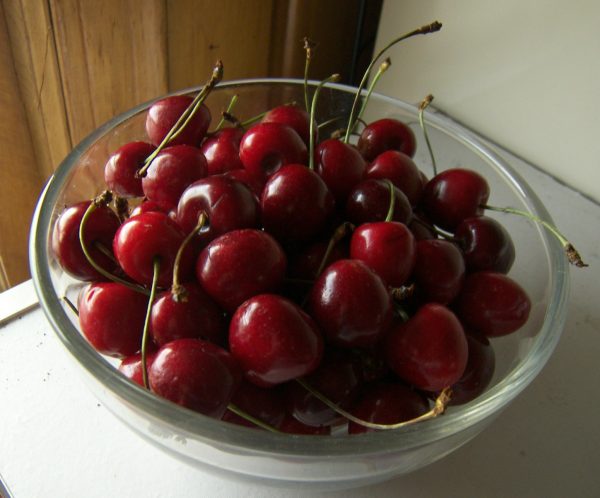
Susceptibility to diseases and pests
The average winter hardiness of the columnar sweet cherry will allow you to get the maximum result in the southern regions of Ukraine, Belarus and Russia. The middle lane and the northern regions will require warming before the cold.
Breeding yielded varieties resistant to diseases, but the columnar cherry is still subject to:
- brown and perforated spotting;
- scab;
- sulfur yellow and false tinder;
- fungal and viral infections.
Like any fruit tree, the columnar cherry is vulnerable to pests:
- tracks;
- weevils;
- moth moth;
- aphids.
Colony cherry is an excellent option to save space and extraordinary layout of the garden plot. In addition to the succulent dessert fruits at the beginning of summer, with proper care, you will receive an ornamental shaped tree.
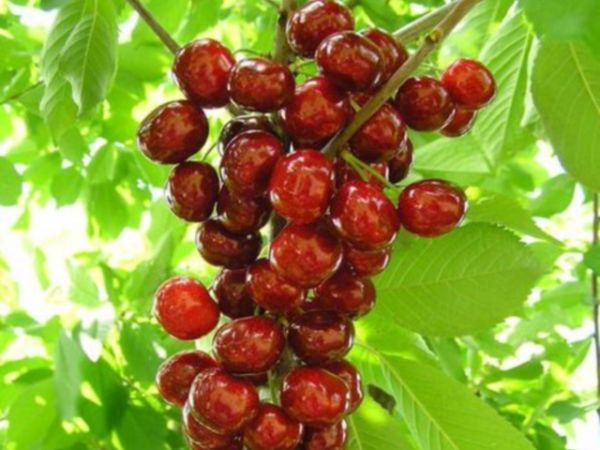
I want to buy seedlings from you.
Adrea don't know
planted cherries of cherries of Helena and Silvia. 3 years in the past have been bearing fruit. But they began to grow somehow to the sides, especially the tip. How to cut them or can leave them. Just stick in the summer. cherries, but kolonovidnoy. why kolonovidnye varieties, the plot is very small and there is no opportunity to grow large-sized trees.